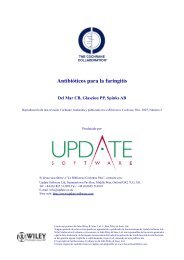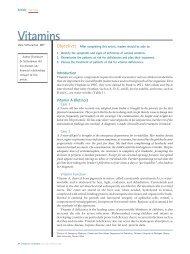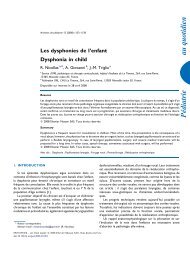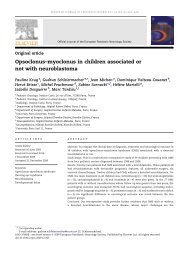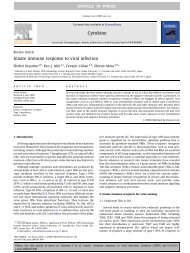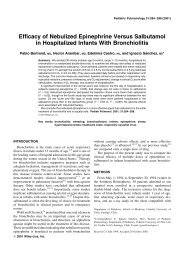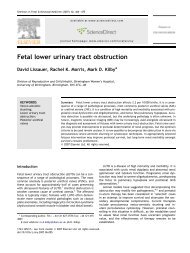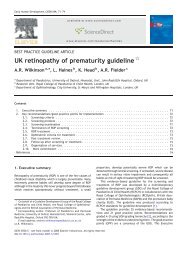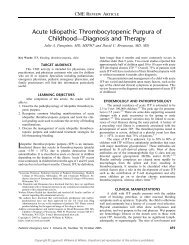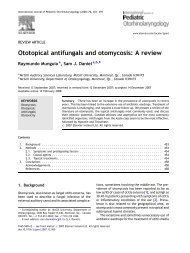Pertussis: a concise historical review including diagnosis ... - sepeap
Pertussis: a concise historical review including diagnosis ... - sepeap
Pertussis: a concise historical review including diagnosis ... - sepeap
Create successful ePaper yourself
Turn your PDF publications into a flip-book with our unique Google optimized e-Paper software.
86 Reviews in Medical Microbiology 2005, Vol 16 No 3<br />
laboratory tool for the <strong>diagnosis</strong> of pertussis in both<br />
the individual patient and in epidemiological studies.<br />
Baughman et al. [100] found a cut off 94 U/ml (FDA<br />
units) diagnostic for a recent infection with B. pertussis.<br />
Since 100 Dutch units equals 125 FDA units [101] this cut<br />
off is considerably lower than the one found by the<br />
Melker et al. [99].<br />
The next question is what is the natural course of IgG-PT<br />
after infection. Accordingly, it is necessary to gain insight<br />
into the rise, peak and decline of IgG-PT after natural<br />
infection with B. pertussis.<br />
Our group used different ways of evaluating the decline<br />
of IgG-PT after natural infection with B. pertussis<br />
[99,102,103]. These three methods reflect gradual improvement<br />
and advances in understanding. In response to<br />
an infection, IgG titres typically show a rapid increase,<br />
followed by a steady, slow decline over several years. IgG-<br />
PT responses appear to show considerable variation<br />
among individual patients.<br />
The first model analyses the association between 2 log<br />
IgG-PT levels and time in 2 log days, fitting a straight line<br />
only accounting for the decaying phase of the response.<br />
This requires omission of data from the initial rapid<br />
increase of IgG-PT [99]. In this study the rapid increase of<br />
IgG-PT in the first weeks after illness was not taken in<br />
account, nor were effects of age or vaccination status.<br />
Since there is no clearly defined criterion by which<br />
observations can be excluded, the following study [102]<br />
continued with a response model, which includes the<br />
initial rising phase. The model that was used, a skewed<br />
hyperbola, has asymptotically linear decline on a log–log<br />
scale at long times from infection. In this model there<br />
seemed a significant effect of age or vaccination status, but<br />
because numbers of adults and unvaccinated infants were<br />
small and because there was a wide variation of data it<br />
remained unclear whether this was clinically relevant.<br />
For any individual patient the amount of information in<br />
this study was limited: only a few measurements at best.<br />
Although the previous regression model adequately fitted<br />
the data, this model did not help much in interpreting the<br />
observed immune responses. For that reason a biologically<br />
based model was developed [103]. The longitudinal<br />
responses are described with a dynamic model of the<br />
interaction between bacteria and the immune system.<br />
This so-called predator–prey model is the simplest<br />
possible model for the interaction between host and<br />
pathogen.<br />
In this study, combining data from patients aged 0–94<br />
years, there were no significant differences found in rise,<br />
peak and decline of IgG-PT between different age<br />
groups. There seems a tendency to age-related differences<br />
where older people tend to have a more rapid increase, a<br />
higher peak and a faster decline after infection than<br />
in younger age groups, which could be caused by<br />
immunological memory.<br />
Since B. pertussis infection is especially dangerous in<br />
young children, not or partially vaccinated, and since the<br />
main source of infection for these children are adults with<br />
often atypical clinical manifestations [104] it is important<br />
to gain insight into the incidence of B. pertussis infection<br />
[103]. Is it possible, once knowing the natural course of<br />
IgG-PT, to calculate the incidence of B. pertussis infection<br />
in the Netherlands in different age groups from available<br />
surveillance data on IgG-PT levels in the general<br />
population?<br />
Earlier de Melker et al. showed that an IgG-PT level of at<br />
least 100 U/ml is present in less than 1% of the population<br />
[99]. De Melker et al. [105], using the statistical model<br />
described by Teunis et al. [102] on the IgG-PT data of a<br />
cross-section of the general Dutch population (n ¼ 7756)<br />
[99] showed that B. pertussis infections occur frequently in<br />
the Dutch population, particularly in adults for whom the<br />
reported incidence is very low. On average the estimated<br />
incidence of infection was 6.6% per year for 3–79-yearolds.<br />
The annual incidence of notified cases was 0.01%.<br />
The age distribution of all infections differs notably from<br />
the age distribution of notified cases. Therefore we<br />
suggest that vaccination strategies should not be based on<br />
notification data but on knowledge about the circulation<br />
of B. pertussis in different age groups and contact patterns<br />
between age groups. Especially for the young, not or<br />
incompletely vaccinated children it is important to<br />
develop vaccination strategies focused on adolescents and<br />
adults as they are the most important source of infection<br />
of these infants [106].<br />
From other studies [17–22,24] it is known that, in some<br />
patients there may be evidence of other pathogens<br />
involved in the pertussis syndrome besides B. pertussis and<br />
in others of pertussis-like complaints without proof of<br />
B. pertussis infection. In a retrospective study for mixed<br />
infections we found that in 28% (23/82 patients) there<br />
was evidence of possible mixed infection with other<br />
pathogens such as parainfluenza virus, respiratory<br />
syncytial virus, Mycoplasma pneumoniae, adenovirus or<br />
influenza virus [107]. Then, to investigate the role of<br />
different respiratory pathogens in prolonged coughing in<br />
children, to confirm the data of the previous study and to<br />
analyse the clinical impact of mixed infections of<br />
B. pertussis with other respiratory pathogens we performed<br />
a prospective study in patients aged 0–18 years<br />
with coughing symptoms lasting 1–6 weeks [108]. In 91<br />
of the 136 included patients one (n ¼ 49, 36%) or more<br />
(n ¼ 42, 31%) possible respiratory pathogens were found.<br />
The most frequent pathogens encountered were rhinovirus<br />
(43 patients, 32%), B. pertussis (23 patients, 17%) and<br />
respiratory syncytial virus (15 patients, 11%). In the 42<br />
patients with a mixed infection the most frequent<br />
combination was B. pertussis and rhinovirus (n ¼ 14).




